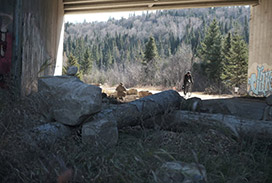Wildlife crossing under Route 117 completed
Pedestrians, cyclists and animals using the P’tit Train-du-Nord are all welcome
There is something new to celebrate on the P’tit Train-du-Nord trail. The Nature Conservancy of Canada (NCC) has held its promise made back in 2019 and has completed upgrades to a wildlife crossing parallel to the popular trail, near Ivry-sur-le-Lac. The tunnel is located on a property that NCC bought three years ago, between Sainte-Agathe-des-Monts and parc national du Mont-Tremblant. The property featured a tunnel used by animals to travel between the Jackrabbit ecological reserve in Montcalm and the Mont-Tremblant National Park. With the support of several partners, NCC was able to make the tunnel more wildlife-friendly by adding boulders, stumps and vegetation to recreate the surrounding habitat. Although this strip of land adjacent to the P’tit Train du Nord trail is not intended for human use, NCC took advantage of the work to install four interpretive panels.
The tunnel is located at a Pinch points for species movement in the Laurentian region. The tunnel, already installed under Route 117, allowed animals to move between the large forests located on both sides of the road, but it was not inviting for the species it was meant to help. From a shrew’s point of view, the tunnel was long and without hiding spaces. Small creatures were, therefore, at the mercy of predators possibly lurking at the exit. Now, rocks, stumps and vegetation line the passage, making it more natural and safer.

Wildlife crossing, Ivry-sur-le-Lac, QC (Photo by NCC)
The new installation allows vegetation to grow naturally in the spring, making the site inviting for wildlife and people. Cyclists and hikers can learn about the wildlife tunnel, the impacts of climate change on wildlife and about vehicle-animal collisions from the interpretive panels set up along the P’tit Train du Nord.
Quote
“As a result of climate change, many plant and animal species will be forced to move northward, which explains the need to maintain natural corridors essential to their adaptation to the new climate realities.” — Caroline Marcotte, project manager at NCC
Acknowledgements
The acquisition of the property by NCC in 2019 as well as the recent installation of the wildlife crossing were made possible thanks to financial support from several partners: the Fondation de la faune du Québec and its financial partner Hydro-Québec; Environment and Climate Change Canada, through its Natural Heritage Conservation Program; ministère de l’Environnement et de la Lutte contre les changements climatiques, through its projects Ensemble pour la nature and Projet de partenariat pour les milieux naturels; ministère des Transports; U.S. Fish and Wildlife Service’s North American Wetlands Conservation Act; Woodcock Foundation; American Friends of Canadian Nature; Trans Canada Trail; private donors; Municipality of Ivry-sur-le-Lac; MRC des Laurentides; Conservation Manitou; Éco-corridors Laurentiens; Echo Fondation; corporation of the P’tit Train du Nord linear park; Concordia University and Énergir.
This project benefits from financial assistance from the Government of Québec under the Action-Climat Québec program and is in line with the objectives of the 2030 Plan for a Green Economy.
Facts
- The average cost of a vehicle–wildlife collision in the Laurentians is $10,671 for a white-tailed deer and $49,388 for a moose. Each year, there are 51 wildlife collisions along approximately 50 kilometres of Autoroute 15 (Route 117).
About
The Nature Conservancy of Canada (NCC) is Canada’s leading not-for-profit private land conservation organization, working to protect our most important natural areas and the species they sustain. Since 1962, NCC has helped to protect more than 15 million hectares, coast to coast to coast, including more than 49,000 hectares in Quebec.
The Ensemble pour la nature project (PEPN) was a three-year, $15 million grant to the Nature Conservancy of Canada (NCC) from Quebec’s Ministère de l’Environnement et de la Lutte contre les changements climatiques (MELCC). Running up until March 31, 2020, it aimed to establish financial partnerships and acquire scientific knowledge to ensure the conservation and protection of natural environments on private lands in Quebec. It thus fostered an interest in the protection of natural environments and encouraged the Quebec community to take action to preserve the environment.
The Projet de partenariat pour les milieux naturels (PPMN) is a four-year grant of more than $53 million from the Ministère de l’Environnement et de la Lutte contre les changements climatiques to NCC. It provides support for voluntary conservation initiatives to ensure the protection of natural areas of interest by establishing financial partnerships with conservation organizations in the province. The PPMN thus aims to develop and consolidate Québec’s network of protected areas located on private land. It follows the Ensemble pour la nature project, which ended on March 31, 2020, and had similar goals.
Learn More
Follow us on Twitter: twitter.com/NCC_CNC | twitter.com/NCC_CNCMedia
Find us on Facebook
- 30 -





